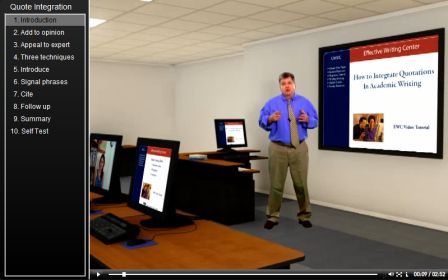
Integrating Quotations: Signals You Must Know
Here is a technique
that
all good research writers use: Signal
your source. Signal your commentary. This technique helps
you avoid the single most common problem when using sources
in papers:
the failure to make a clear distinction between what belongs to you and
what belongs to your sources. The failure to make that distinction can
lead to the charge of plagiarism.
Here is another important reason to signal your source and signal your commentary: The signals help your paper to flow more smoothly and to be more convincing.
Since your sources can only support your points (not make them for you), the signals help the reader see exactly how the experts support your arguments.
Signal Your Source
Whether you are quoting from a source or summarizing information from it in your own words, signaling your source means to introduce it:
When it comes to
hiring, the teaching profession offers a decent outlook. According
to the U.S. Department
of Labor (2010), "Job opportunities for teachers over
the next 10 years will vary from good to excellent, depending on the
locality, grade level, and subject taught."
The quotation is preceded by the signal phrase "According to the U.S. Department of Labor." This signal phrase clearly says to your reader: Here is an expert source to back up what I just said!
Signal Verbs (Keep this list
handy):
Your sources can: address, admit, analyze, believe, confess, confirm,
contribute, critique, debate, debunk, defend, define, discover,
disprove, establish, evaluate, examine, extend, finish, formulate,
identify, prepare, propose, question, recommend, reiterate, report,
suggest, think, urge--and a lot of other things. Examples:
A report by Richard Rodderick defends the practice of xenotransplantation by pointing to the 97 lives saved during one year in California.
A report by Richard Rodderick recommends the practice of xenotransplantation, pointing to the 97 lives saved during one year in California by the procedure.
A report by Richard Rodderick establishes a baseline of successful xenotransplantation cases with 97 lives saved during one year in California by the procedure.
Signal Your Commentary
After
you
have signaled your source and cited it, you have one more task as a
research writer: Now you must comment on the source you just used. The
comment that you make allows you to transition to your next point or
source and to further integrate the quotation with
your own thoughts and words. The comment should provide a clear
connection between the
source and the point you are making.
The follow-up comment also serves as the second of two brackets at
either end of
your source. Here are the two brackets in red, with the source
sandwiched between:
When it
comes to hiring, the teaching profession offers a decent outlook. According
to the U.S. Department of Labor (2010), "Job
opportunities for teachers over the next 10 years will vary from good
to excellent, depending on the locality, grade level, and subject
taught. This
rating of "good to excellent"places teaching at the top of my
career list.
Integrating
Sources Video
If you experience problems playing the video, try copying and pasting
this URL in a new browser window:
https://youtu.be/rfvxKRH0KmU